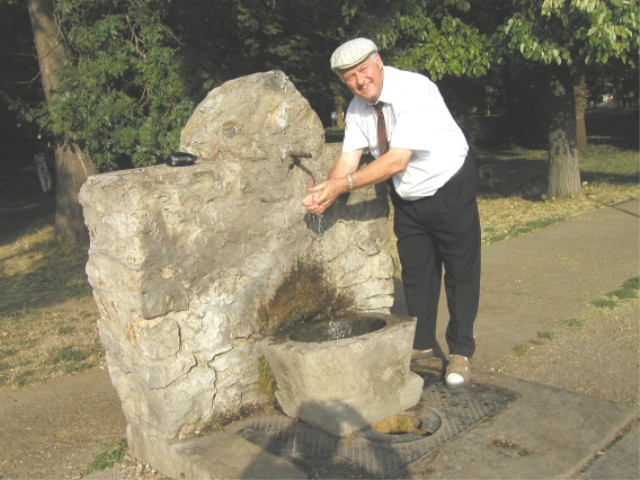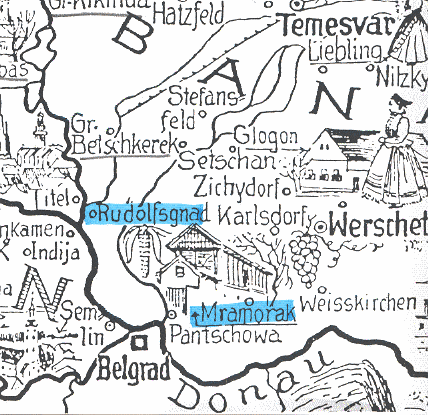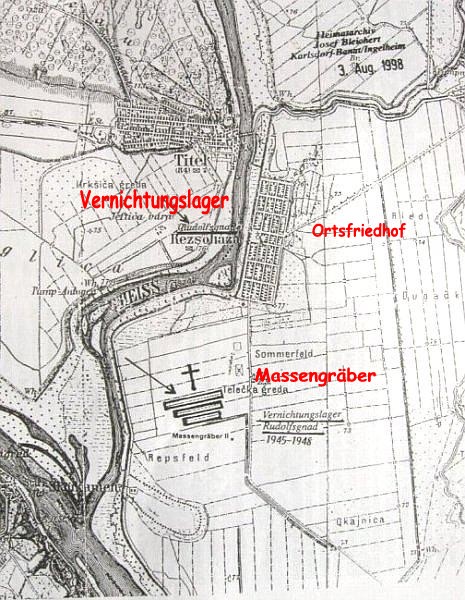
 |
A child from Mramorak: Memories of life

(At the well in Mramorak - Pastor Jakob Stehle - 2003)
When I think of the BANAT and DANUBE-PEOPLE, I think of two villages in particular: MRAMORAK and RUDOLFSGNAD.
First of all, we were "only" REFUGEES after World War II, both in Austria and in Germany. We were "displaced people". - Hardly anyone in Germany knew about the Banat. - Above all, there are two places that remind me of my homeland: MRAMORAK and RUDOLFSGNAD.
MRAMORAK
I was born in Mramorak (11.2.1942). At the time of my birth, my father was with the German Wehrmacht.
In the care of the mother - first in the clubhouse of the Germans (my mother used the rooms) - and in the house of the grandmother (the grandfather was with the German working group - OT - Organisation Todt) grew up together with my sister Elisabeth.

After the withdrawal of the German soldiers and the coming of the partisans, we lived from May 1945 to October 1945 in a ghetto around the German church and German school imprisoned in their own village.
At the end of 1945 we were taken by cattle railway to Rudolfsgnad. - Without the courage of the mother to get food, I would have starved.
In the middle of 1947 we tried to escape and were caught. - At the end of 1947 we managed to escape and we arrived in Austria via Hungary - and ended up in refugee camp No. 63 at Bindermichel (Linz).
Here we lived for several years until we were able to leave for Germany - 1955.
It took a long time for me to grasp the tragedy of this brief biography. - In the beginning, only the "expulsion of the Germans from the former Banat" was spoken. There was nothing in the textbooks. It was not talked about at school. Even in the then former Meiden (newspapers and radio and later on television), the fate of us Donauschwaben did not come up. - It was still about the many thousands of soldiers who were imprisoned in Russia.
The fact that in the view of us Donauschwaben is ultimately about human rights violations was not an issue. - One spoke of the "expellees" - and popularly of the "refugees".
The word "discrimination" - namely a German minority - was not heard.
The parents and grandparents and relatives still spoke of the "good old days" in their homeland - also of the hope, when the German army invaded Yugoslavia in the former kingdom. - But all was in vain! - We were treated as "foreigners" - as "anymies".
At the inauguration of the memorial in JAREK in 2017, the "disappearance of the Danube Swabians" (official version in today's Serbia) was discussed. What a cover! - And still many church ruins and some dilapidated cemeteries testify to the life of the Germans in the former Banat!
But that the history of the Danube Swabians could become a "lesson" on flight and expulsion was not discussed. In the face of today's events of worldwide flight and global displacement, this moves into the consciousness of the people - and thus also the Danube Swabians was thought. - Unfortunately one speaks in one breath of the "Danube Swabian refugees" and the "today's refugees"! That the Danube Swabian refugees were expelled because of their German, is overlooked. - That they returned to the homeland of their ancestors, is the least aware.
Our compatriots were deeply traumatized after the war and tried as well as possible to gain a foothold in the homeland of the ancestors. - First of all, it was the search for an apartment, the food and drink, the concern for the children to go to school.
And the big dream was to have your own house again.
No one thought about the psychological care of the "refugees"! - For many years, they only had a second-rate identity card.
It often came out of false shame to belong to the refugees, to self-denial. One was ashamed of his Danube Swabian dialect. The Red Cross was used to search for the people who were considered "missing".
These terrible experiences of the Danube Swabians found no place in the new homeland and the national republican memory.
On the following pages, therefore, the history of the village Rudolfsgnad and the fate of the inhabitants for the present generation and for our descendants is recorded. It is intended to honor the founders and inhabitants of the community as well as all the victims of the notorious death camp Rudolfsgnad.
Further translation soon!
RUDOLFSGNAD
 Das war das zweite Wort in meiner Lebensgeschichte. - "Hungerslager" sagten die einen; andere sprachen von "Vernichtungslagern". In den damaligen Landkarten fand sich mir der Ort nicht, wußte ich doch nicht, daß es schon lange einen anderen Namen trug: Knicanin.
Das war das zweite Wort in meiner Lebensgeschichte. - "Hungerslager" sagten die einen; andere sprachen von "Vernichtungslagern". In den damaligen Landkarten fand sich mir der Ort nicht, wußte ich doch nicht, daß es schon lange einen anderen Namen trug: Knicanin.
Dan erfuhr ich, daß es das größte Lager (im Englischen sprechen wir von "Konzentratinslager") war, die im nachfolgenden kommunistischen Jugoslawien für die Deutschen eingerichtet wurde. - Eine ehemalige deutsche Ortschaft an der Mündung der Theiß in die Donau. Sie war am Ende des Zweiten Weltkrieges mit dem Abzug der deutschen Armee geräumt worden. - Es war zum "Lager im Sonderstatus" (was das auch immer bedeutete) für die deutsche Restbevölkerung.
(Siehe: "Leidensweg der Deutschen im kommunistischen Jugoslawien." - Donauschwäbische Kulturstiftung (Hg.) Band III.- München/Sindelfingen 1995. S. 107
[www.kulturstiftung.donauschwaben.net/]
Das Lager war von Oktober 1945 bis März 1948 in Betrieb. Insgesamt wurden durch das Lager 33.000 Personen geschleußt; der höchste Belegungsstand betrug zwischenzeitlich rund 20.500 Personen. Die Zahl der Opfer beläuft sich auf rund 11.000 Personen. Im Mai 1946 befanden sich unter den rund 18.000 Insassen 46% Kinder unter 14 Jahren.
Mein Besuch der Gedenkstätte in Rudolfsgnad:
Im Jahr 2000 gelingt es dem Sekretär der Ortsverwaltung von Knicanin, Sruboljub Stoikovic für die Idee einer Gedächtnisstätte zu gewinnen. Er beantragt und erhält die Baugenehmigung zur Restaurierung der Friedhofskapelle. Im Juli 2001 wird der Vertag zum Wiederaufbau der Kapelle abgeschlossen. Die Fertigstellung erfolgt im Oktober 2001 und die Einweihung erfolgt unter der Schirmherrschaft von Ministerpräsident Erwin Teufel
2001 erfolgt die offizielle Zuteilung von einem Hektar Land für die Gedenkstätte Teletschka (als Friedhof eingetragen, zur Nutznießung erhalten). In der Zwischenzeit ist auch ein Gedenkkreuz auf der Teletschka entstanden.
An das Gedenkkreuz angrenzend wurden Stelen aufgestellt, auf denen Ortsgemeinschaften ihre Todeszahlen eingravieren lassen können.
In großer Freundlichkeit wurden wir von der heutigen Ortsverwaltung bei unserem Besuch aufgenommen - und konnten im dortigen Feuerwehrhaus mit unseren Landsleuten essen und trinken. - Ich brach ein Stück Brot und erklärte: Hier im "Hungerslager" war jeden Tag nur ein Satz zu hören: "Ich habe Hunger!"
Siehe meinen Reisebericht von 2003

Ansprache: Peter Zimmermann - 2008
Geschichte der Donauschwaben - Ansiedlung (von Franz Gaubatz und Georg Bader)
Siehe das Zeitzeugnis eines Lagerinsaßen: Zeitzeuge - Franz Apfel
The organization Todt (OT) was a paramilitary construction group in National Socialist Germany, which bore the name of its leader Fritz Todt (1891-1942). Founded in 1938, the organization was in March 1940, this also as Reich Minister of Armaments and Munitions (RMfBM and the successor ministry under Albert Speer). It was used after the beginning of World War II, especially for construction in the territories occupied by Germany. It became known through the expansion of the western wall, the construction of submarine bases on the French coast and the "Atlantic Wall" (bunkered artillery and defensive positions). From 1943 she built the launchers of the V1 and V2 rockets. In the summer of 1943 followed by the expansion of air raid facilities for the civilian population (extended LS guide program) and the underground displacement of industrial enterprises. Forced laborers, prisoners of war and concentration camp inmates were often used in the organization since the beginning of the war.
(Source: Wikipedia
|
|
![[Church - Mramorak]](kirchturm3.jpg)


